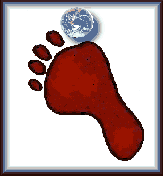| Urban Environmental Management |
 |
Urban and
Ecological Footprints |
|
 "Earth provides enough to satisfy every man's need but not every man's greed." "Earth provides enough to satisfy every man's need but not every man's greed."
- Mahatma Gandhi
|
 onsider the immense pressure put on the environment. Researchers Bill Rees and
Mathis Wackernagel have developed the ecological footprint concept - the area of land
needed to provide the necessary resources and absorb the wastes generated by a onsider the immense pressure put on the environment. Researchers Bill Rees and
Mathis Wackernagel have developed the ecological footprint concept - the area of land
needed to provide the necessary resources and absorb the wastes generated by a
Tread lightly on the Earth |
community - to highlight the impact of cities on the environment. London, UK serves as a
good example: the ecological footprint of that city is 120 times the area of the city itself.
They estimate that a typical North American city with a population of 650,000 would
require 30,000 square kilometres of land - an area roughly the size of Vancouver Island,
Canada - to meet domestic needs alone without even including the environmental demands
of industry. In comparison, a similar size city in India would require 2,800 square
kilometres.
Planners are faced with enormous challenges in providing a secure environment that meets
the needs of both people and natural systems. And cities are not self-contained entities.
Their problems and solutions are part of and impinge on those in other jurisdictions,
putting even more pressure on already over-burdened local governments.
|
| Documents and Reports |
|
| Organizations and programmes |
|
| Footprint Calculators and Tools |
|
| Urban Footprints |
- Berlin, Germany
- Helsinki, Finland
- Liverpool, UK [PDF - 1.3 mb]
- London, UK
- Manali, India
- Santiago, Chile
- Sonoma County, USA
- Tokyo, Japan
- Toronto, Canada
- York, UK
- Scotland's Footprint
- Northern Limits: Northern Ireland
|
| So what do we do now?? |
|
| Related concepts and issues |
|
 |
|
|
|
|
| |
More than one million people are added to the world's cities each week, and by the year 2000 over a half of the total world population will be urban.
September 23: As of today, humanity will have consumed all the new resources the planet will produce this year, according to Global Footprint Network calculations. For the rest of the year, we will be in the ecological equivalent of deficit spending, borrowing from the future.
 GDRC calculated the ecological footprint of Tokyo metropolitan area. It turned out to be almost three times the land area of Japan as a whole
|


